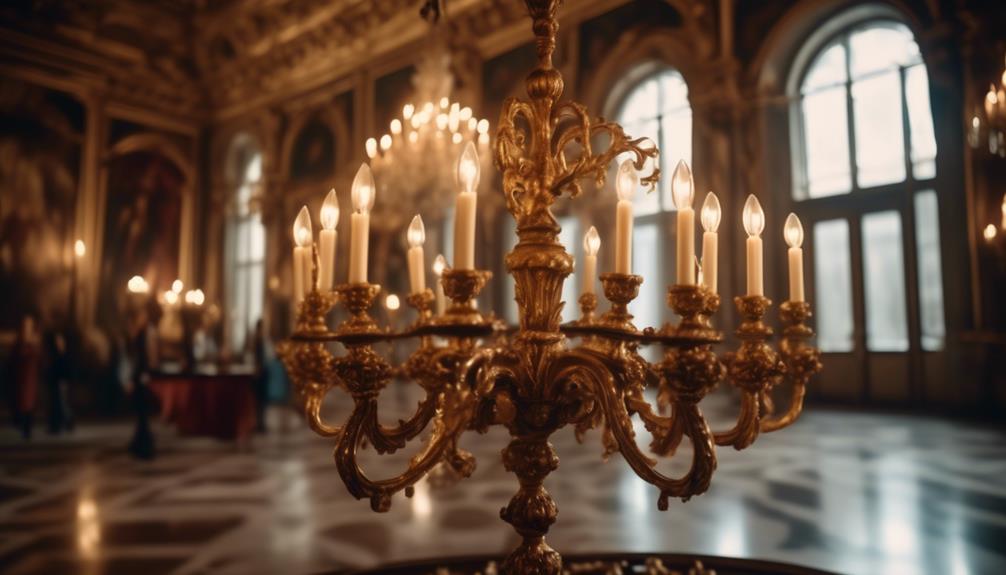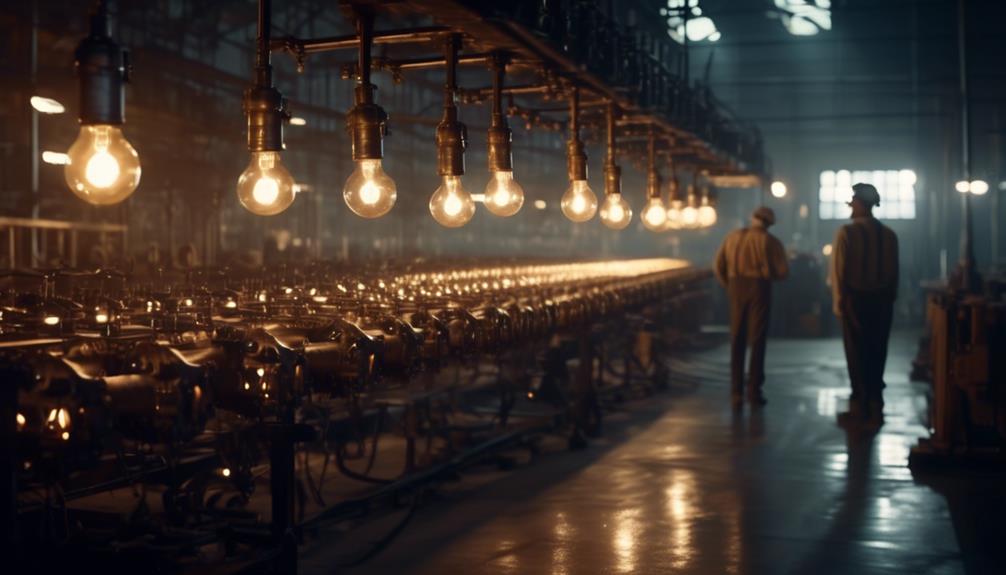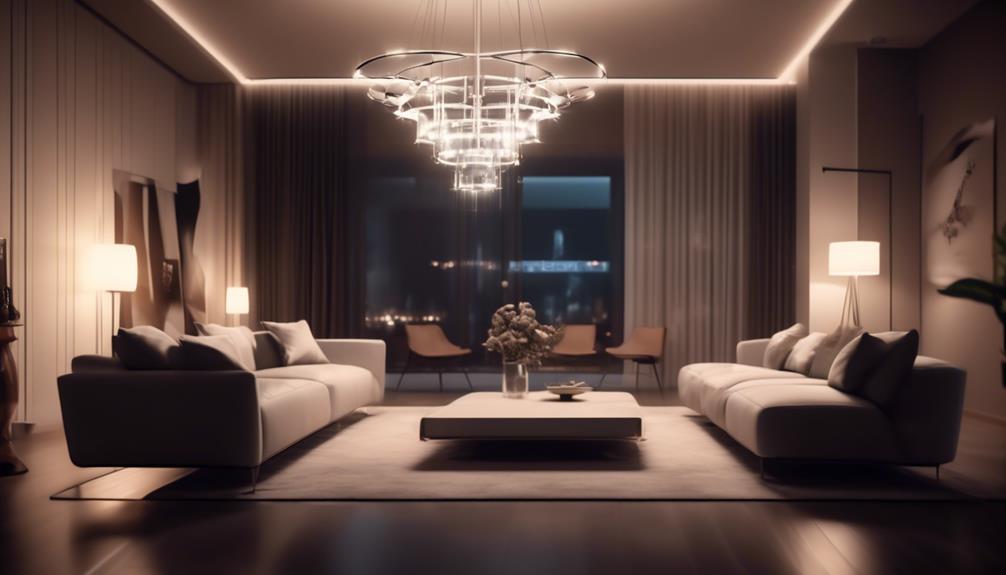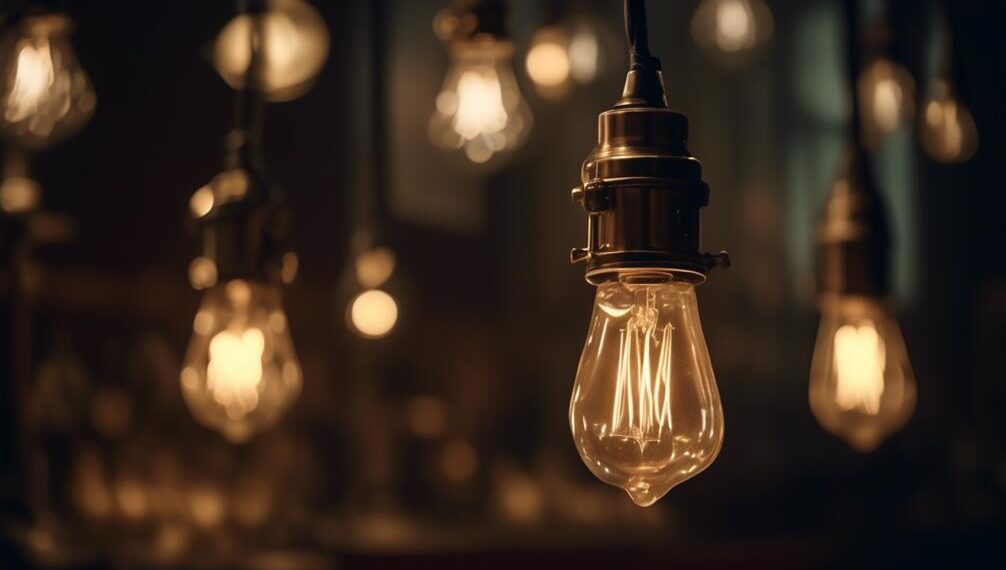Step into the illuminating world of lighting design, where historical events have played a pivotal role in shaping trends and techniques.
Like a tapestry woven with threads of time, each historical era has left its mark on the way we illuminate our spaces.
From the ancient civilizations who harnessed the power of fire to the modern technological advancements that have revolutionized the way we experience light, the influences of the past continue to cast their glow upon the present.
So, let us embark on a journey through time, as we uncover the fascinating ways in which historical events have shaped the art and science of lighting design.
Key Takeaways
- Ancient civilizations such as the Egyptians, Greeks, Romans, and Mesopotamians used lighting techniques to enhance architectural aesthetics and symbolize religious beliefs.
- The Renaissance period saw the emergence of artistic lighting, where natural light and different lighting techniques were used to evoke emotions and create depth in paintings and sculptures.
- The Industrial Revolution brought about the rise of electric lighting, which revolutionized lighting design and transformed the way people lived and worked.
- The World Wars and post-war reconstruction led to advancements in functional lighting, with a focus on safety, efficiency, and providing sufficient illumination for various tasks.
Ancient Civilizations and Their Impact

Ancient civilizations greatly influenced the development of lighting design trends, shaping the way we perceive and utilize light in various contexts. Architectural advancements and cultural symbolism played significant roles in these influences.
In terms of architectural advancements, ancient civilizations such as the Egyptians, Greeks, and Romans made significant contributions to lighting design. The Egyptians, for example, constructed temples with narrow openings called clerestories, which allowed natural light to enter and create an ethereal atmosphere. The Greeks, on the other hand, introduced the concept of the skylight, using a series of openings in the roof to bring in natural light and enhance the visual aesthetics of their buildings. Similarly, the Romans developed the concept of the oculus, a round opening in the roof that not only provided light but also served as a symbolic representation of the divine.
Cultural symbolism also played a crucial role in ancient lighting design. For instance, in ancient Mesopotamia, the ziggurats were built with a staircase-like structure, where each level represented a different deity. The lighting design in these structures was carefully crafted to highlight the importance of each deity and create a sense of reverence. In ancient China, the use of lanterns during festivals symbolized the hope for a bright future and the sharing of joy with the community.
These architectural advancements and cultural symbolism not only influenced lighting design in ancient times but continue to shape our perception and utilization of light in modern contexts. Whether it's the use of natural light to create a certain ambiance or the incorporation of symbolic lighting elements in religious or cultural spaces, the influence of ancient civilizations on lighting design is undeniable.
Renaissance and the Birth of Artistic Lighting

The Renaissance period marked a pivotal moment in lighting design, giving birth to a new era of artistic illumination. During this period, artistic innovations and cultural influences played a significant role in shaping the way lighting was used to enhance the visual experience. Artists and architects began to experiment with different lighting techniques to create a sense of depth, realism, and drama in their works.
One of the key artistic innovations of the Renaissance was the use of chiaroscuro, a technique that involved the juxtaposition of light and shadow to create a three-dimensional effect. This technique was widely used by painters such as Leonardo da Vinci and Caravaggio, who understood that the manipulation of light could dramatically transform a scene.
Cultural influences also played a crucial role in the development of artistic lighting during the Renaissance. The rediscovery of ancient Greek and Roman art and literature sparked a renewed interest in the aesthetics of classical antiquity. This led to a revival of interest in natural light and its ability to evoke a sense of harmony and beauty.
In addition, the rise of humanism during the Renaissance placed a greater emphasis on the individual and the exploration of human emotions and experiences. Lighting became a powerful tool for expressing these ideas, as it could be used to create moods and atmospheres that reflected the inner states of characters or conveyed specific messages.
Industrial Revolution and the Rise of Electric Lighting

With the advent of the Industrial Revolution, the world witnessed a transformative shift in lighting design as electric lighting emerged as a revolutionary technological advancement. The rise of urbanization during this time period played a significant role in the popularity and adoption of electric lighting.
- Improved visibility: Electric lighting provided a more efficient and reliable source of illumination compared to traditional methods such as gas lamps or candles. This allowed urban areas to be illuminated more effectively, enhancing visibility and safety during nighttime.
- Social interaction: The availability of electric lighting also impacted social dynamics in urban settings. Streets, parks, and public spaces could now be illuminated, creating opportunities for people to gather and engage in social activities after dark. This fostered a sense of community and contributed to the growth of public events and nightlife.
- Enhanced productivity: The introduction of electric lighting transformed the industrial landscape by extending working hours. Factories and workplaces could now operate round the clock, increasing productivity and accelerating industrial growth. This shift also had a profound impact on the daily lives of individuals, as they could now engage in leisure activities or pursue personal interests after work.
The rise of urbanization and the widespread adoption of electric lighting during the Industrial Revolution not only revolutionized lighting design but also had a profound impact on social dynamics, transforming the way people lived, worked, and interacted in urban environments.
World Wars and the Need for Functional Lighting

During the World Wars, functional lighting became a crucial aspect of military operations and everyday life, as it played a vital role in ensuring safety, efficiency, and communication in various settings. The impact of post-war reconstruction on lighting design was significant, as the need for functional lighting in homes, workplaces, and public spaces increased. Innovations in lighting technology during wartime also paved the way for advancements in the field.
| Impact of Post-War Reconstruction on Lighting Design | Innovations in Lighting Technology during Wartime | Benefits of Functional Lighting |
|---|---|---|
| The destruction caused by the wars led to the need for | The development of portable and durable lighting | Enhanced safety and security |
| rebuilding cities and infrastructure. This created a | solutions such as the flashlight and the portable | Improved efficiency and productivity |
| demand for efficient and cost-effective lighting | searchlight. | Effective communication |
| solutions that could be implemented on a large scale. | ||
| The focus shifted towards functional lighting that | The use of fluorescent lamps and incandescent bulbs | Proper illumination for tasks |
| provided sufficient illumination for various activities | for military applications. | increased morale and well-being |
| and helped create a sense of normalcy. |
The need for functional lighting during the World Wars had a lasting impact on lighting design. The post-war reconstruction efforts led to the development of innovative lighting solutions that could be implemented on a large scale. The advancements in lighting technology, such as portable and durable lighting solutions, fluorescent lamps, and incandescent bulbs, not only improved safety and efficiency but also enhanced communication and productivity. Functional lighting provided proper illumination for tasks, increasing morale and well-being in various settings. The World Wars were a turning point in lighting design, as they highlighted the importance of functional lighting and paved the way for future advancements in the field.
Modern Technology and the Future of Lighting Design

In the realm of lighting design, the integration of modern technology has revolutionized the way we approach illuminating spaces and has paved the way for the future of the industry. With advancements in artificial intelligence and sustainable lighting solutions, the possibilities are endless. Here are three key ways in which modern technology is shaping the future of lighting design:
- Artificial intelligence and lighting design: Artificial intelligence (AI) has the potential to transform the way we control and automate lighting systems. Through AI algorithms, lighting can be adjusted based on occupancy, time of day, and even individual preferences. Imagine a world where your lighting automatically adjusts to your mood or the task at hand, creating the perfect ambiance for every moment.
- Sustainable lighting solutions and their impact: The push for sustainability has led to the development of innovative lighting solutions that are energy-efficient and environmentally friendly. LED technology, for example, consumes less energy and has a longer lifespan compared to traditional incandescent bulbs. Additionally, smart lighting systems can optimize energy usage by dimming or turning off lights in unoccupied areas. These sustainable lighting solutions not only reduce carbon footprint but also result in significant cost savings.
- Integration of lighting with other technologies: Modern technology allows for the seamless integration of lighting with other smart technologies. Imagine a lighting system that's synchronized with your home automation system, adjusting lighting levels based on your activities or even syncing with your music playlist. The future of lighting design lies in its ability to work in harmony with other technologies, creating a truly immersive and personalized experience.
As the field of lighting design continues to evolve, the integration of modern technology will undoubtedly play a crucial role in shaping its future. From AI-driven lighting systems to sustainable solutions, the possibilities are exciting and limitless. Embrace the freedom of technological advancements and get ready to experience a whole new level of illumination.
What specific historical events have had the most significant impact on lighting design trends?
The invention of the incandescent light bulb by Thomas Edison in 1879 marked a turning point in historical lighting design trends. This groundbreaking technology revolutionized indoor lighting, leading to the creation of more varied and innovative lighting fixtures that continue to influence historical lighting design trends today.
Frequently Asked Questions
How Did Ancient Civilizations Like the Egyptians and Greeks Use Lighting in Their Daily Lives?
Imagine walking through the halls of an ancient Egyptian temple, the warm glow of oil lamps illuminating intricate hieroglyphics. Greeks, on the other hand, embraced natural light, designing open-air amphitheaters that basked in the sun's golden rays.
What Were Some of the Key Artistic Lighting Techniques Developed During the Renaissance?
During the Renaissance, artists developed various lighting techniques to enhance their artworks. These techniques included chiaroscuro, tenebrism, and sfumato, which allowed for dramatic contrast, depth, and soft transitions of light and shadow in Renaissance art.
How Did the Industrial Revolution Contribute to the Rise of Electric Lighting?
During the Industrial Revolution, the impact was immense! Technological advancements led to the rise of electric lighting, transforming the way we illuminate our world. It brought freedom from darkness and sparked a new era of design possibilities.
How Did World Wars I and II Affect the Development of Functional Lighting?
During World Wars I and II, the development of functional lighting was greatly influenced by the need for efficient and adaptable lighting in military operations. These historical events had a significant impact on lighting design trends.
What Are Some Emerging Technologies That Are Shaping the Future of Lighting Design?
Smart lighting and sustainable lighting are two emerging technologies that are shaping the future of lighting design. These advancements are revolutionizing the way we illuminate our spaces, providing greater control, energy efficiency, and environmental sustainability.








